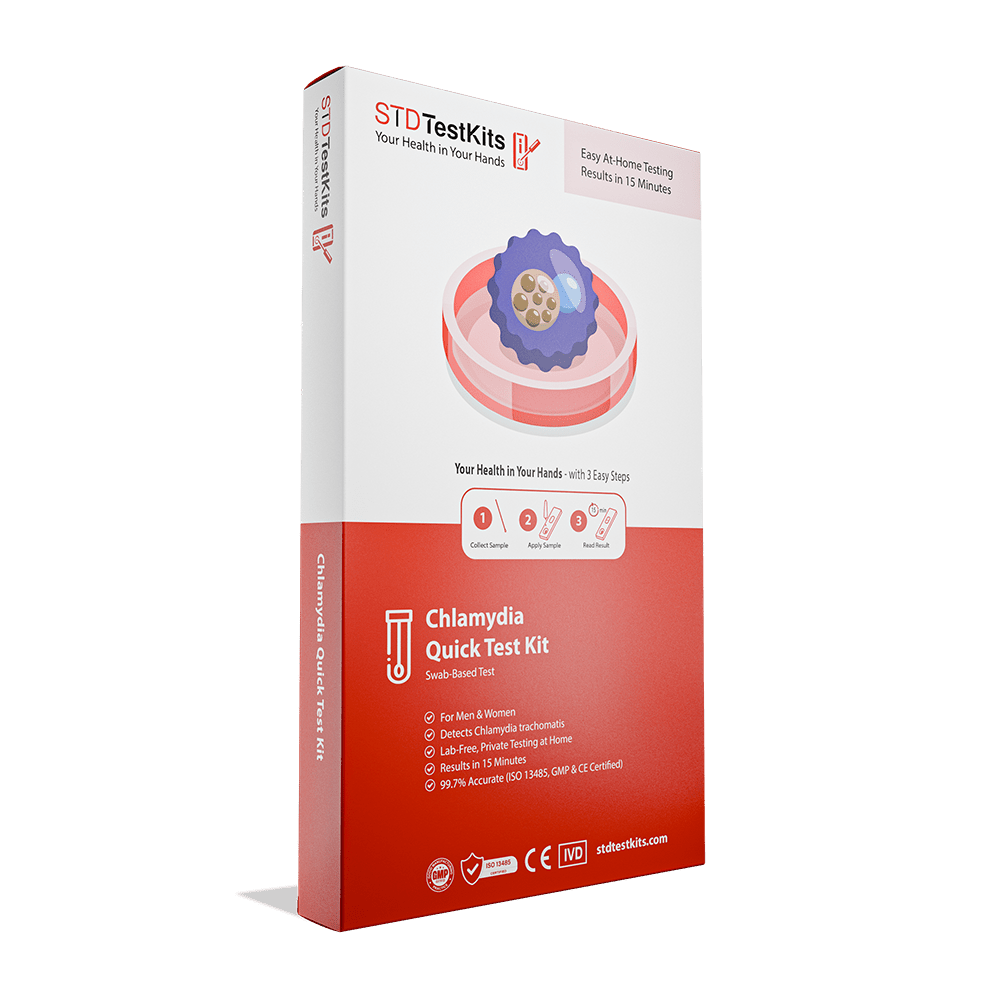Can You Trust a Hepatitis B Home Test? Here’s the Truth
Quick Answer: Chlamydia in gay men frequently goes undetected because rectal and oral infections often cause no symptoms and are not included in routine STD tests unless specifically requested.
“It Was Just Oral”: How Risk Gets Downplayed
There’s a common misconception in both public health messaging and gay sexual culture: oral sex is “low risk” and therefore safe. But while HIV risk is significantly lower from oral than from anal sex, chlamydia doesn’t follow the same rules. It spreads easily through mucosal contact, including oral-genital or oral-anal contact, and may colonize the throat or rectum without ever touching the urethra.
In one 2021 study published in Sexually Transmitted Diseases, researchers found that over 70% of rectal chlamydia cases in MSM were asymptomatic. Many of these infections would have been missed by standard urine tests alone.
The problem compounds when health providers assume heterosexual default risks. Unless patients disclose specific acts or advocate for comprehensive testing, many clinics won’t perform rectal or throat swabs, even when they're clearly needed.

People are also reading: Can You Get an STD from Hands Alone?
Invisible Infections: Why Rectal and Throat Chlamydia Rarely Show Symptoms
One of the main reasons chlamydia goes undetected in MSM is simple: it often doesn’t hurt. Literally. Unlike urethral infections, which may cause burning, discharge, or pain during urination, rectal or oral infections can be entirely silent.
Even when symptoms do appear, they’re often mistaken for something else:
Table 1. How chlamydia symptoms in gay men often go unnoticed or misattributed to unrelated issues.
Because most people only associate STDs with pain or discharge, it’s easy to dismiss these signs, or lack thereof, especially if the last encounter was oral-only. And when a test does happen, the sample site matters. A negative urine test won’t catch a rectal infection.
What Gets Missed: The Problem With Standard STD Panels
Here's the brutal truth: unless you ask for a throat or rectal swab, most testing providers won’t offer it. Even in LGBTQ+ clinics, it's common for first-time patients to receive urine-only or urethral swab testing, despite national guidelines recommending multi-site testing for MSM who engage in oral and anal sex.
According to the CDC’s STI Treatment Guidelines, comprehensive screening for sexually active MSM should include testing at all exposed sites, urethra, rectum, and oropharynx, every 3 to 6 months depending on risk level. But actual implementation varies wildly.
Even popular at-home STD test kits may fall short. Many don’t include the option to collect throat or rectal samples unless specifically chosen or paid for. If you're using a urine-only kit, you could get a false sense of security from a negative result, even while carrying the infection in your rectum or throat.
If this sounds familiar, you're not alone. One anonymous user in a Reddit thread said:
“I got tested at a clinic after some rough oral and everything came back negative. A month later I had rectal bleeding and went back, they found chlamydia in my butt, but not my pee.”
“I Was Negative, Until I Wasn’t”
Ramon, 27, had been seeing someone casually for a few months. They used condoms for anal, but not for oral. After a flu-like sore throat, he decided to get tested at a walk-in clinic. The provider ran urine tests and blood work for HIV and syphilis. All negative.
But two weeks later, his partner complained of anal discomfort. They both went to a queer-friendly clinic that offered throat and rectal swabs. Ramon's rectal chlamydia test came back positive, even though his urine sample was still clean.
“I felt betrayed by the first clinic,” Ramon said. “They made me feel safe, like I was clear. But no one even asked what kind of sex I was having.”
Ramon’s experience shows how diagnostic blind spots can turn into real transmission risk, not because people are careless, but because systems aren’t built to see the full picture of queer sexual health.
Order a discreet chlamydia test kit that can help you test at home without judgment, and without waiting for a provider to ask the right questions.
When Safe Feels Risky: The Myths That Let Chlamydia Spread
Most MSM don’t ignore their health. The issue isn’t negligence, it’s misinformation. Between outdated sex ed, rushed clinical visits, and mainstream messaging that centers heterosexual transmission, queer men are often left with the wrong impression about risk.
Here are a few myths that fuel the epidemic:
Table 2. Persistent myths about chlamydia risk in gay men, and what they get dangerously wrong.
These myths aren’t just mistakes, they’re systemic failures. Medical institutions, insurance policies, and even some clinics continue to treat sexual risk as something narrowly defined. But sex is more complex. So is exposure. So is testing.
Can You Get Chlamydia From Oral Sex? Yes, And Here’s How
Chlamydia is caused by the bacterium Chlamydia trachomatis, which thrives in moist mucous membranes, especially in the urethra, rectum, throat, and cervix. That means oral-genital and oral-anal contact can absolutely transmit it.
In fact, a 2022 meta-analysis in The Lancet Infectious Diseases confirmed that throat infections are common in MSM and may be a key transmission point, especially when untreated. Saliva, deep kissing, and oral-anal rimming can all play a role, although more research is still needed.
The takeaway? You can get chlamydia from oral sex. You can give it from the throat to a partner’s genitals. And you can carry it for weeks without knowing. That makes it a perfect silent passenger, and an urgent public health concern.
So, When Should You Test?
If you’re sexually active and MSM, you should test every 3 to 6 months, even if you feel fine. And after any high-risk exposure or new partner? Get tested within 14 days, and retest again at 4 to 6 weeks if anything felt off or went unprotected.
Let’s break that down in real-world terms:
- Hooked up with someone new and gave oral? Test at 14+ days post-exposure, and request a throat swab.
- Had receptive anal sex? Test rectally, even if you used a condom (they don’t cover everything).
- Had a negative urine test but symptoms persist? Retest with a full panel that includes oral and rectal samples.
Here’s how exposure and timing intersect:
Figure 2. Optimal testing timeline for chlamydia after different exposures in MSM.
Feeling confused or worried? You don’t have to wait for a clinic. This at-home combo test kit lets you discreetly check for common STDs with medical-grade reliability, right from home.
Retesting After a Positive Result: What You Should Know
First, if you test positive, take a breath. Chlamydia is common, curable, and treatable with one round of antibiotics. But retesting is still critical, especially if the infection was in your rectum or throat.
The CDC recommends retesting three months after treatment to ensure clearance. Why? Because reinfection is common, especially if a partner wasn’t treated or if the infection lingered in another body site undetected.
For MSM, here’s a safe retesting strategy:
- Initial test positive in rectum? Retest at 12 weeks with a new rectal swab.
- Partner never tested? Suggest they test too, or use anonymous partner notification tools.
- Still experiencing symptoms? Get re-evaluated even sooner, within 4 to 6 weeks post-treatment.
One Reddit user said:
“I got treated for chlamydia but kept getting anal pain weeks later. Turned out I had a throat infection that wasn’t tested. Took another round to get clear.”

People are also reading: How Accurate Is a Syphilis Rapid Test?
At-Home Testing vs Clinic Visits: What Works Best for MSM?
For a lot of gay and bisexual men, going to a clinic for STD testing is hard both logistically and emotionally. Traditional testing methods don't work for everyone because some people are afraid of being judged, don't have access to queer-affirming care, or just find it inconvenient.
That’s where at-home testing comes in. But not all kits are created equal. Some only offer urine tests. Others require you to know exactly which samples to take (throat, rectum, urethra), which most people aren’t trained to decide. That’s why choosing the right kit matters, especially for MSM who need multi-site testing based on actual exposure, not assumptions.
Let’s compare the options:
Table 3. Comparing testing options by privacy, scope, and use case for MSM.
Why Shame Delays Testing, and How to Break the Cycle
To be honest, gay men are often told that their sex lives are dangerous, irresponsible, or dirty. Because of this cultural residue, many people feel ashamed of things like STDs even when they haven't done anything wrong. That shame can make people wait to get tested, stop talking about it, and in the end, make the infection last longer and spread more by accident.
But the truth is that taking a test doesn't mean you're guilty. It's a promise to take care of yourself, your partners, and your health in the future.
Devon, 31, avoided testing for a year because his last clinic visit ended with a provider questioning his “lifestyle.” After finally ordering an at-home kit with rectal swabs, he tested positive for chlamydia.
“I wasn’t even mad I had it. I was mad no one told me I should have been testing differently this whole time,” he said.
Devon’s story echoes countless others, smart, health-conscious gay men falling through the cracks of a system that wasn't built with them in mind. It's not about who you are. It’s about what kind of sex you have, and how well the healthcare system recognizes that.
How to Talk About Testing With Partners (Without Shame)
If you’ve tested positive, or just want to stay ahead of things, talking with your partners can feel intimidating. But MSM communities have long led the way in open communication and harm reduction. Here’s how to do it without guilt or fear:
- Normalize the conversation. Say, “Hey, I’m trying to stay on top of my health. I get tested every few months, want to do it together?”
- If you test positive, give facts, not apologies. “I tested positive for rectal chlamydia. It doesn’t always show up in standard tests, so I just wanted to let you know so you can check too.”
- Offer resources. Link them to easy test options or clinics. Better yet, send them a link to an at-home kit.
- Use anonymous partner notification tools if the conversation feels unsafe or complicated. Many public health departments have online portals that let you notify past partners without revealing your identity.
Remember: testing isn’t just about protection. It’s about connection. It says: I care enough about you to be real. And if someone shames you for that? They’re not someone who deserves your body.
You Can’t Treat What You Don’t Test
Here’s what all of this comes down to: being symptom-free doesn’t mean you’re STD-free. And in the gay community, where rectal and oral infections are often invisible, chlamydia continues to circulate, not because people are reckless, but because they’re under-informed or under-tested.
If your last test didn’t include a rectal or throat swab, you might not be as clear as you think. But that doesn’t mean panic. It means power. You get to take the reins now. You get to decide what peace of mind looks like for you.
FAQs
1. Can you really get chlamydia from oral sex?
Yes, oral sex can absolutely transmit chlamydia. It’s not just a “safer” version of sex; it’s still mucous membranes exchanging bacteria. You could pick it up from giving or receiving oral, even if no one finishes. If someone has it in their throat or genitals, that contact is enough.
2. Why didn’t I have any symptoms?
Most people don’t. Especially with rectal or throat infections, you might feel totally fine. No burning, no discharge, nothing. That’s the scary part, chlamydia doesn’t always make noise, but it can still be spreading silently to every partner you touch.
3. I tested negative. Could it still be chlamydia?
Unfortunately, yes. A standard STD test might only check urine. That won't catch throat or rectal infections. So if you’ve had oral or receptive anal sex and the symptoms don't add up, or if your partner tests positive, go back and ask for full-site testing.
4. How long after a hookup should I get tested?
Aim for about 14 days after the encounter. Earlier than that, and the test might miss it because your body hasn’t built up enough detectable bacteria yet. If you’re unsure or anxious, test now, and retest in two weeks to be safe.
5. What’s the difference between a throat infection and a genital one?
Location and symptoms. Throat infections might just feel like a mild sore throat, if anything. Genital chlamydia tends to cause burning or discharge. But again, some folks get neither. That’s why test site matters more than guessing based on how you feel.
6. Can I use an at-home test if I think I have throat or rectal chlamydia?
Yes, but make sure you get the right kind. Many kits only include urine tests, which won’t help here. Look for multi-site kits with swabs for your throat and rectum. This combo kit includes them all, no guessing required.
7. Do I have to tell my partner if I test positive?
You should. Not because you're “in trouble,” but because they deserve to know. You can keep it simple: “I tested positive, and it might’ve come from or gone to you. It’s treatable, but you should check too.” There are even anonymous text services if a direct convo isn’t safe or possible.
8. Will antibiotics clear it for good?
Yes, when taken correctly, a short course usually clears chlamydia. But here's the catch: if you still have it in another site (like your throat) or your partner didn’t get treated, you could get reinfected fast. That’s why retesting is key.
9. What if I don’t get treated?
Left untreated, chlamydia can cause serious issues. In guys, it can lead to testicle pain, fertility problems, and raise your risk of getting or giving HIV. In the rectum, it can cause inflammation you might not notice, until it's done damage. Don’t wait it out. Treat it early.
10. How often should I test if I’m sexually active with men?
If you’ve had a new partner or multiple partners in the past three to six months, you should be testing that often, every 3–6 months. Think of it like STI hygiene. You're not paranoid, you're responsible
How We Sourced This Article: We combined current guidance from leading medical organizations with peer-reviewed research and lived-experience reporting to make this guide practical, compassionate, and accurate. In total, around fifteen references informed the writing; below, we’ve highlighted some of the most relevant and reader-friendly sources.
Sources
1. CDC: STI Treatment Guidelines
2. Planned Parenthood: Chlamydia Information
3. CDC — STI Screening Recommendations (including for MSM)
4. CDC — Chlamydial Infections Treatment Guidelines
5. “Sexually Transmitted Infections: Updated Guideline From the CDC” — AAFP
About the Author
Dr. F. David, MD is a board-certified infectious disease specialist focused on STI prevention, diagnosis, and treatment. He blends clinical precision with a no-nonsense, sex-positive approach and is committed to expanding access for readers in both urban and off-grid settings.
Reviewed by: A. Bennett, MPH | Last medically reviewed: October 2025
This article is for informational purposes and does not replace medical advice.







